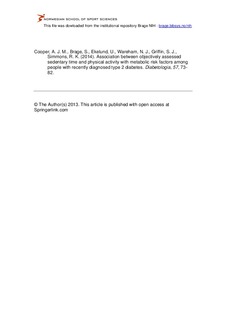| dc.description.abstract | Aims/hypothesis: The aim of our study was to examine the associations between sedentary time (SED-time), time spent in moderate-to-vigorous-intensity physical activity (MVPA), total physical activity energy expenditure (PAEE) and cardiorespiratory fitness with metabolic risk among individuals with recently diagnosed type 2 diabetes.
Methods: Individuals participating in the Anglo-Danish-Dutch Study of Intensive Treatment in People with Screen Detected Diabetes in Primary Care (ADDITION)-Plus trial underwent measurement of SED-time, MVPA and PAEE using a combined activity and movement sensor (n = 394), and evaluation of cardiorespiratory fitness (n = 291) and anthropometric and metabolic status. Clustered metabolic risk was calculated by summing standardised values for waist circumference, triacylglycerol, HbA1c, systolic blood pressure and the inverse of HDL-cholesterol. Multivariate linear regression analyses were used to quantify the associations between SED-time, MVPA, PAEE and cardiorespiratory fitness with individual metabolic risk factors and clustered metabolic risk.
Results: Each additional 1 h of SED-time was positively associated with clustered metabolic risk, independently of sleep duration and MVPA (β = 0.16 [95% CI 0.03, 0.29]). After accounting for SED-time, MVPA was associated with systolic blood pressure (β = −2.07 [−4.03, −0.11]) but not with clustered metabolic risk (β = 0.01 [−0.28, 0.30]). PAEE and cardiorespiratory fitness were significantly and independently inversely associated with clustered metabolic risk (β = −0.03 [−0.05, −0.02] and β = −0.06 [−0.10, −0.03], respectively). Associations between SED-time and metabolic risk were generally stronger in the low compared with the high fitness group.
Conclusions/interpretation: PAEE was inversely associated with metabolic risk, whereas SED-time was positively associated with metabolic risk. MVPA was not associated with clustered metabolic risk after accounting for SED-time. Encouraging this high-risk group to decrease SED-time, particularly those with low cardiorespiratory fitness, and increase their overall physical activity may have beneficial effects on disease progression and reduction of cardiovascular risk. | nb_NO |
